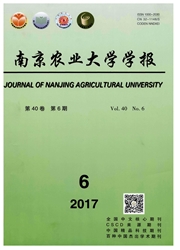

 中文摘要:
中文摘要:
应用棉饼稻草日粮,配合饮水中添加氧化镁的饲喂模式,对6只阉割公山羊诱发尿石症,观察尿石症发生过程中尿液晶体、电导率和磷酸钾镁离子积的动态变化,以探讨其变化规律及在尿石症诊断中的应用价值。试验分4个时期进行,预试结束时为试验Ⅰ期;正式试验的第15~60天为试验Ⅱ期;尿闭发生初期为试验Ⅲ期;尿闭发生后2~5d为试验Ⅳ期。结果表明,试验山羊都发生了尿石症,尿结石和试验Ⅱ期尿沉渣晶体主要由磷酸铵镁和磷酸钾镁组成,试验Ⅳ期晶体主要为磷酸钾镁。试验Ⅱ期尿液中存在数量较多、大小不同的晶体,试验Ⅲ期晶体基本消失,试验Ⅳ期则出现少量小晶体。试验Ⅲ、Ⅳ期尿液电导率和磷酸钾镁离子积都显著低于Ⅰ、Ⅱ期(P〈0.05)。提示:山羊的磷酸铵(钾)镁结石形成后,尿液的电导率和磷酸钾镁离子积水平降低,尿沉渣晶体减少或消失。
 英文摘要:
英文摘要:
A new mode of urolithiasis was induced in 6 wether lambs by feeding with cottonseed meal diet and water containing MgO, and the changes of urinary crystals, urinary conductivity and urinary activity product of potassium magnesium phosphate were evaluated during the onset of urolithiasis, and clinical diagnostic value of urolithiasis was also discussed. The experiment was divided into four periods: the end of pre-testing designed as period Ⅰ , days 15 -60 of experiment as period Ⅱ , the initial stages of dysuria as period Ⅲ, and 2 - 5 days after dysuria as period Ⅳ. The result showed that urolithiasis occurred in all six experimental goats and the main compositions of crystals in period Ⅱ and stone were of potassium magnesium phosphate and ammonium magnesium phosphate in experiment, but the crystal in period Ⅳ was potassium magnesium phosphate. Crystals emerged largely with different size in urine of period Ⅱ and disappeared in period Ⅲ, but small crystal could be found again in urine of period Ⅳ. Both urinary conductivity and activity product of potassium magnesium phosphate of period Ⅲ, Ⅳ were lower than period Ⅰ and Ⅱ ( P 〈 0.05 ). It was suggested that urinary conductivity and activity product of potassium magnesium phosphate decreased during the onset of ammonium (potassium) magnesium phosphate calculosis, urinary sedimentary crystal lessened or disappeared during this process.
 同期刊论文项目
同期刊论文项目
 同项目期刊论文
同项目期刊论文
 Reduced PKC alpha expression in pulmonary arterioles of broiler chickens is associated with early fe
Reduced PKC alpha expression in pulmonary arterioles of broiler chickens is associated with early fe Expression of PDGF-beta receptor in broilers with pulmonary hypertension induced by cold temperature
Expression of PDGF-beta receptor in broilers with pulmonary hypertension induced by cold temperature 期刊信息
期刊信息
